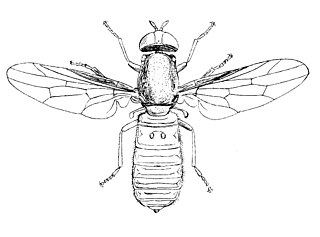
North Cape / Otou is the northernmost point of New Zealand's main islands. At the northeastern tip of the Aupōuri Peninsula, the cape lies 30 kilometres (19 mi) east and three kilometres (1.9 mi) north of Cape Reinga. The name North Cape is sometimes used to refer just to the cape that is known in Māori as Otou and which overlooks Murimotu Island, and sometimes just to the eastern point of Murimotu Island. It is also used to refer to the whole larger headland stretching about five kilometres from Murimotu Island westwards to Kerr Point and including the Surville Cliffs. Statistics New Zealand uses a statistical area called North Cape for population data, extending south down the Aupōuri Peninsula to the Houhora Heads.

Empididae is a family of flies with over 3,000 described species occurring worldwide in all the biogeographic realms but the majority are found in the Holarctic. They are mainly predatory flies like most of their relatives in the Empidoidea, and exhibit a wide range of forms but are generally small to medium-sized, non-metallic and rather bristly.

The Scenopinidae or window flies are a small family of flies (Diptera), distributed worldwide. In buildings, they are often taken at windows, hence the common name window flies.

Empis borealis is a species of dance flies in the fly family Empididae. It is found in most of Europe, except the Balkan Peninsula, the Baltic Region and the Iberian Peninsula. The brown wings of the female are very broad, while the male fly’s wings are narrower.

Empis ciliata, the black dance fly, is a species of dance fly, in the fly family Empididae. It is included in the subgenus Euempis.

Drapetini is a tribe of hybotid flies widespread in the world. There are 19 currently recognised genera. See the Wikispecies link below for details.

Hemerodromiinae are a worldwide group of predatory flies in the family Empididae with raptorial forelegs.

Empidinae, also called dance flies, are a subfamily of empidoid flies. They are mainly predatory flies like most of their relatives, and generally small to medium-sized. Most species are flower visitors and they can be effective pollinators.
Syneches hyalinus is a species of hybotid dance fly in the family Hybotidae.
Syneches debilis is a species of hybotid dance fly in the family Hybotidae.

Ragadidae is a family of true flies in the superfamily Empidoidea. It was formerly considered a lower taxon, but was published as a new subfamily within Empididae in 2016. Since then, it has been classified as the sister group to Empididae, and has been elevated to family level based on the genetic differences which separate it from Empididae.
Empidadelpha is a genus of dance flies in the family Empididae.
Chelifera is a genus of flies in the family Empididae.
Phyllodromia striata is a species of dance flies, in the fly family Empididae.
Thinempis austera is a species of dance flies, in the fly family Empididae.
Gynatoma quadrilineata is a species of dance flies, in the fly family Empididae.
Hilarempis dichropleura is a species of dance flies, in the fly family Empididae.
Hilarempis simillima is a species of dance flies, in the fly family Empididae.
Hilarempis trichopleura is a species of dance flies, in the fly family Empididae.
Homalocnemis is a genus of flies which is placed in a family of its own, the Homalocnemidae. There are about seven species in the genus found in the Afrotropical, Neotropical, and Australasian regions, suggestive of a Gondwanan origin. The genus was formerly considered a primitive empidoid and placed variously in the Hybotidae or in the empidid subfamily Brachystomatinae. They are recognized by their wing venation which includes a long anal cell and a long basal segment of the antennal style.








